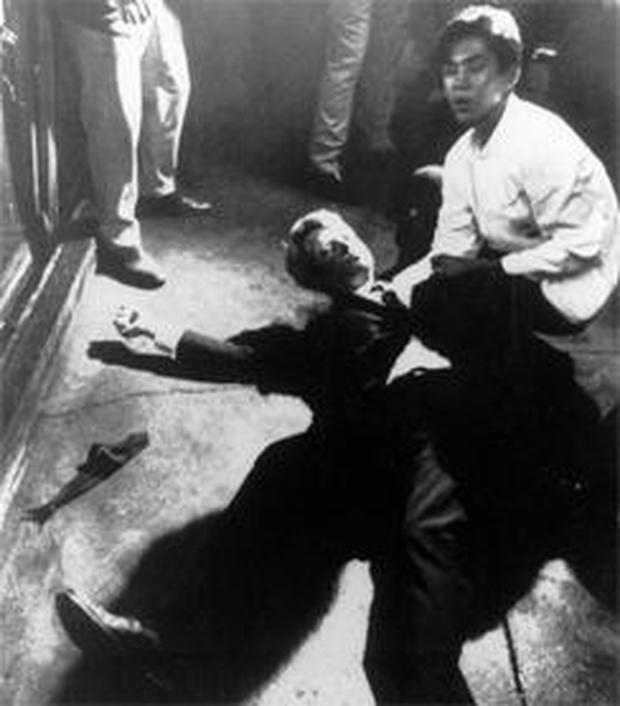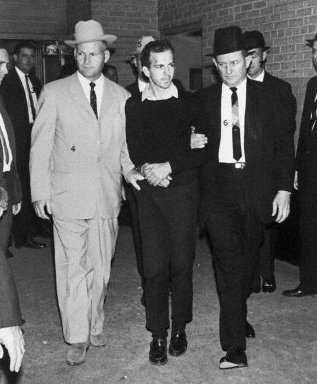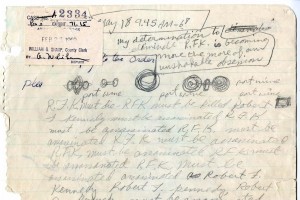THE LAST ACTS OF ROBERT F. KENNEDY …
A CALL FOR A NEW INVESTIGATION
By Robert D. Morningstar
(Copyright 2018, R.D. Morningstar – All Rights Reserved)
*******
On May 28th, CBS News broadcast “Breaking News” …
CBS NEWS Reports:
“RFK Jr. Seeks New Investigation into Father’s Assassination
Fifty years after the assassination of Sen. Robert F. Kennedy, his son is calling for a new investigation. The presidential candidate was shot and killed in Los Angeles in 1968. Sirhan Sirhan, the man convicted for Kennedy’s murder, is serving a life sentence.
Last year Robert F. Kennedy Jr. met face-to-face with Sirhan, and he says he left that meeting believing that the gunman was falsely accused.
He told the Washington Post this weekend that once he saw the autopsy report, “I didn’t feel it was something I could dismiss. I was disturbed that the wrong person might have been convicted of killing my father.”
On the night of June 5, 1968, Kennedy was celebrating his victory in California’s Democratic presidential primary. As he was leaving, he was shot three times. He died a day later. Five others were hit but survived. Police arrested 24-year-old Sirhan Sirhan, who admitted to killing RFK, but said he had no memory of the event.
(Editor’s Note: That last claim by CBS News is a non sequiter (dislogic), which creates an irreconcilable parados, to wit:
How can someone “admit” to doing something that …
One Cannot Remember doing? -> M* – Ed.)

Senator Robert Kennedy awaits medical assistance as he lies on the floor of the Ambassador Hotel in Los Angeles moments after he was shot June 5, 1968. BORIS YARO/LOS ANGELES TIMES
Sirhan was standing in front of Kennedy at the time of the shooting, but an autopsy report found Kennedy was shot at point blank range from behind.
Over the years new evidence reportedly shows as many as 13 shots were fired that night. But Sirhan’s gun held only eight bullets. That’s one reason why many now question Sirhan’s guilt – including Robert Kennedy Jr.”
Read the entire article here:

“Will He Dare Run in 1968”
A taunting headline from Time-Life aimed right at RFK in 1966
Time marches on …
and we too must move on to:
THE LAST ACTS OF ROBERT F. KENNEDY
A Study in Self-Defense That Reveals the Identity of the RealAsssassin
*******
Greetings to All on this Memorial Day
May 29th, 2018
This is traditionally a day of solemn commemoration of our national heroes who served our country with, in Lincoln’s words, “the last full measure of devotion.” Such man was Robert F. Kennedy and I remember him as vividly today as on the day I met him that June day in 1967, exactly year before he died.
I feel it is fortunate that his son, Robert F. Kennedy Jr., recognizes that the time has come, that the time is now to shed new light on history, and the need for a new investigation.
Sadly. such an illumination of facts surrounding the death of his father (and uncle) must surely raise the dead from their graves and bring some of America’s oldest skeletons to Light on this Memorial Day, including that of his own father, RFK.
With the hope of sparking new investigations into political assassinations in our country since JFK, I offer the following geometric and logical proof of the identity of the actual killer and his actions, taken on that fateful night in June of 1968.

Photographic Evidence Exists
In photos taken seconds before the shooting of RFK, Thane Eugene Caesar, a hotel “rent-a-cop” security guard is to be seen walking behind RFK just off his right shoulder and, very importantly, Cesar is shown wearing a tie.
Thane Caesar an avowed supporter of Gerorge wallace & White Supremacy was the real killer who executed RFK firng point blank into his head. RFK went down, but it was not without a fight against is killer.
My fellow JFK researcher, Roy Schaeffer, discovered this and told me about it more than 30 years ago, but the photos proving it were hidden until jwe located them a few years ago. The most important one is attached below,
As he was being shot, RFK reacted to Caesar’s attack from behind while turning away from Sirhans shots coming from the front. As Cesar put his gun to RFK’s head, the Senator turned violently to the right, reaching out with his right arm to protect himself.
RFK’s last action and motions as he was shot was to grasp Thane Caeser by the throat.
Cesar struggled to break away from RFK’s grip as he and the Senator fell to the floor.
Struglling with his victim, Thane Cesar broke Kennedy’s grip and saved his throat, but not before RFK had ripped Caesar’s clip-on tie right off his neck and then clutched it strongly to his chest as the chaos unfolded.
For more than 40 years, the Deep Stae actors, the CIA, FBI and the LAPD, with the help of hundreds Mockingbird Media harpies have hidden the most important photos of the dying Senator, photos that showed his clenched fist, holding Thane Cesar’s ripped-off clip-on tie, and held to his chest as he lay on his back, dying and waiting for medical attention.
In most news media photos, for more than 45 years, the photo in question has been cropped to show only RFK is shown close-up wearing a tie. Magazine, books and TV news all used close-ups that cropped out Robert Kennedy’s clenched fist, gripping Thane Cesar’s tie on his chest.
Here is a quote from the report linked below
“Cesar has denied firing his weapon. He was interviewed within minutes of the shooting by John Marshall, a radio reporter, and said:
“I was there holding his arm when they shot him”
and
“As he (Kennedy) walked up, the guy pulled a gun and shot him.”
He said he was on Kennedy’s right side. He stated that he reached for his gun but “it was too late.”
“Police at the scene did not examine Cesar’s gun.”
(Bold emphasis M*)
https://heavy.com/news/2018/05/thane-eugene-cesar/
It took Roy Schaeffer and me decades of searching to find these rare photos, such as the one below, showing the entire scene after RFK released the clip-on tie from his grip to fall away on the ground.
I will have to search my archives for the before and after photos of Thane Caesar wearing the clip-on tie and walking behind before the shooting and the after photo showing him in shock, with is shirt torn open and the top button torn off, and most significantly, missing his clip-on tie, which he could not retrieve from Robert Kennedy’s clench..ed fist.
One of the reasons that I know more than most people do about Thane Caesar, aside from my studies of the films and the photo evidence, is that I had the privilege of hearing a secretly recorded interview with Thane Caesar himself, tricked into a discussion as he walked with the reporter who had targetted him as the potential killer and actually stalked him back to his home town, and casually made friendly contact enough over a short time, to get him to boast a bit about “what he saw.”
The interview I refer to above was uncovered and broadcast on Pacifica Radio by my colleague, investigative and radio journalist, Dr. Gary Null, in 1997.
Once the reporter gained his confidence, Thane Ceasar discussing his (Caesar’s) political affiliations in 1968. Now, consider this, beside being a hired as “rent-A-cop” security guard for RFK on the night of his assassination, what was Thane Cesar’s “day job”?
Here is very interesting information about Cesar, cited from the article linked above:
“He was rejected by the LAPD and became a plumber,”
And here is yet another intersting quotation:
Thane Cesar’s other job was ” a plumber at Lockheed Aircraft”!
I’m sure that title meant something like a “Watergate plumber.”
This detail revealed to me that Thane Cesar was part and parcel of the Military-Industrial Complex, and a member of its defense intelligence security apparatus (with a direct connection to the LAPD).
Thane Cesar’s prior connection to LAPD is fascinating, as is the fact that the LAPD did not check or test Cesar’s gun even though he claims thathe proffered it more than once. That sounds to me like he was “In Like Flynt” as a liason with the LAPD, which may have given him the lead (and a recommendation) for a job at Lockheed as, if one could believe it, as a “plumber”!
Now. during the secretly recorded interview, Thane Cesar, in describing his feelings about the assassination of Robert F. Kennedy, was candid and his voice, in its tones and vocabulary, made it abundantly clear that Thane Casesar’s personal feelings regarding the murder of RFK were like fond memories, and betrayed as such by his snarky comments about RFK, as well as, his giggles and laughter when discussing the unfolding of the shooting, the outcome of the event and its historic aftermath.
The shot to RFK’s head, according to L.A. Coroner Thomas Noguchi was fired from “point blank range,” in fact n farther than “1 to 1 1/2 inches away” and was so close to RFK that the gunfire left singed hair and skin, powder burns, gunpowder residue on RFK’s hair and clothing.
The other 3 shots struck RFK from below and rising up meaning that the shooter was lower than he was, and obviously had to have been fired fter he head shot and so had to come in as RFK was falling, meaning that the shooter was firing from below as he to (the shooter) was falling under the target of the assasination, Robert F. Kennedy.

Let’s study the Geometry of an Assassination
![]()
Thane Cesar is to be seen in photos walking close to RFK just seconds before the shooting. At first, Cesar was walking 1 to 2 feet behind the Senator, and with the press of the crowd in later photos, walking on his right side, and then not photographed but by his own admission, Cesar was walking alongside RFK, “holding his arm,” and of course, with no other person between them; on the other side was Security Guard Graves, also holding Robert Kennedy’s left arm.
Think of their postures and relative positions, with one “cop” on the right, and one “cop” on the left, each holding the arm of the soon-to-be victim.

Is this not exactly what we see “going down” in the Dallas PD basement when Jack Ruby shot Lee Harvey Oswald?
All that was missing were the handcuffs!
What better way to assassinate someone is there than to have 2 people holding the victim by both arms in the line of fire, or actually acting in secret as assassins themselves, with the perfect alibi and under the pretense of having been “guarding ” the victim?
That was the “perfect cover,” but first …
FIRST, THERE MUST BE A DISTRACTION
A few seconds later, the shooting rang out …
Sirhan fired first, from 8 -10 feet away, initiating the proposed sequence of events described below.
The most importantant point is that the the autopsy shows that the head shot hit 1 and 1/2 inches from the skull and left burns and residue …
That alone eliminates Sirhan’s shots.
But the other 3 shots were fired from below RFK, with their trajectories going from low to high …
Why?
The answer lies in the fact that Sirhan fired first (as a distraction) as Thane Cesar raised his gun into position. Cesar was able to get his first shot off, as RFK reacted quickly, both turning away from the front shots, and acting in self-defense, fending off at the real killer behind him.
In the struggle, Senator Kennedy succeeded in ripping off his assailant’s tie while falling on Thane Cesar as he fired the last 3 shots upward into the Senator’s upper rib cage with one shot passing through the upper body, exiting the front below the right clavicle, or collar bone.
In the struggle, the Senator’s coat jacket was torn or cut at the yoke and left sleeve area. The right sleeve was intact, but Senator Kennedy’s coat was torn at the top of the right shoulder region.
How can we explain the torn and rent fabric of the yoke and sleeve of the Senator’s coat when Sirhan never touched him.?
Let’s ask ourselves, in a densely packed crowd, as there was moving about and pressing through the hotel kitchen, who could get into position so quickly as to fire a shot just 1 1/2 inches from the victim’s skull?
Here are 3 Essential Ingredients for a successful assassination are:
Motivation
Means
Opportunity
Motivation: The killer would have to have motivation for the killing, and being an extreme right wing, pro George Wallace member of the John Birch Society. Those views qualify Thane Cesar and he possessed the motivation for politcal assassin.
Means: Especially in a close quarters situation, as with Ruby shooting LHO, with the intended victim surrounded by a densely packed crowd, I would say it would have to be someone who had to gvien ready access to the victim and had to be prepositioned and walking closest to the victim.
Opportunity: What better way to insure opportunity to succeed in killing RFK than to preposition the killer right alongside the victim with the perfect cover story of “security guard”?
That security guard was Thane Cesar …
“a plumber at Lockheed Aircraft. ”
SIRHAN SIRHAN WAS NOT “PALESTINIAN”
Another detail that few people know is that Sirhan Sirhan is NOT a “Palestinian.”
Though Sirhan born in Jerusalem, Sirhan’s family was a Maronite Christian family from Lebanon, and their immigration to the United States was sponsored by none other than Richard M. M. Nixon.
Yes, the same “Tricky Dick” who had employed Jack Ruby as his informant since 1947, and head of the executive action 5412 Committee during the Eisenhower administration, when he was Vice-President.
The 5412 Committee was the “assassination arm” of the National Security Council, which Col. Fletcher Prouty dubbed “The Secret Team,”


A closer look at Thane Eugene Cesar
at the Assassination of RFK
RFK and the Clip-on Tie in the Killing of Bobby Kennedy
HD-Stabilized
https://www.youtube.com/watch?v=s8lWYFslP8c

June 6th, 1968
666



Did a treacherous Cesar kill the Senator?
Wishing all my readers a Good Memorial Day …
I will also be remembering JFK on the 101st anniversary if his birth in Brookline Massachussets,
May 29th, 1917.
My epitaph for Brothers Jack and Bobby remains:
“Greater love hath no man than to lay down his life for his friend” …
Or for his Brothers.
Let us contemplate that on this Memorial Day.
Robert D. Morningstar
New York City
May 29th, 2018

Avise La Fin
ADDENDUM:
DISTRACTOR
PSYCHOLOGICAL ASSESSMENTION OF SIRHAN SIRHAN
May 2008
Sirhan Bishara Sirhan:
Trained by Coercive Persuasion Techniques
To serve as a Distractor at RFK’s assassination
By Dr. Daniel Brown
from: “The Full Story of the Sirhan Sirhan Parole Hearing”
Another important document submitted to the parole board two days before the hearing was a new declaration by Dr. Daniel Brown,[10] a psychologist from Harvard Medical School. Since May 2008, Dr. Brown has spent over 100 hours with Sirhan, including a two-day visit last September.
The aim of these sessions was threefold: to “conduct a detailed forensic psychological assessment” of Sirhan’s mental status; to allow Sirhan “to develop a more complete memory…for the events leading up to and of the night of the assassination”; and to determine whether or not Sirhan was the “subject of coercive suggestive influence” at the time of the shooting and if this accounted for his amnesia.
The declaration states that, in Dr. Brown’s expert opinion, Sirhan is normal, does not have a psychiatric condition or personality disorder and shows no evidence of any violence risk if released (the primary consideration for any parole panel).
In his sessions with Sirhan, Dr. Brown found “a variety of personality factors that are associated with high vulnerability to coercive suggestive influence: an extreme dissociative coping style; hypnotically-induced altered personality states; extremely high hypnotizability; and high social compliance”:
Mr. Sirhan is one of the most hypnotizable individuals I have ever met, and the magnitude of his amnesia for actions not under his voluntary [control] in hypnosis is extreme. This unusual combination of personality factors makes Mr. Sirhan the type of individual extremely vulnerable to coercive social influence [and accounts for his] uncharacteristic behavior and strong amnesia for that behavior on the night of Senator Kennedy’s assassination…
Dr. Brown’s declaration traces the seeds of this “coercive suggestive influence” back to his experiences at a local race track, where,
Mr. Sirhan regularly practiced self-hypnosis with fellow stable boys…Mr. Sirhan was observed to quickly enter a very deep state of hypnotic trance state and to then respond compulsively and uncritically to suggestion the [sic] behave in certain ways for which he subsequently became amnesic….
After a fall from a horse at a ranch in Corona in 1966, Sirhan was briefly hospitalized but, as Dr. Brown notes,
The medical record of the hospital shows that he was treated for a minor eye injury and discharged the same day. His mother and best friend both states [sic] that he was missing for two full weeks. Mr. Sirhan recalls being in the hospital for several weeks. Sometime thereafter he was taken to a military firing range and trained to shoot upon command at vital human organs while in an hypnotic state.
Dr. Brown notes that Sirhan’s “dissociative vulnerability” causes him “on rare occasions to shift self-states”:
On more than one occasion I was able to find the cue to induce “range mode,” wherein upon hypnotic cue, Mr. Sirhan takes his firing stance, hypnotically hallucinates that he is shooting at circle targets at a firing range, automatically starts shooting, and subsequently is completely amnesic for the hypnotically induced behavior. This altered personality state only occurs while Mr. Sirhan is in a hypnotic or self-hypnotic state, and only in response to certain cues. This state never spontaneously manifests. While in this altered personality state, Mr. Sirhan shows both a loss of executive control and complete amnesia….[T]his distinctive self-state is cue-specific and state-dependent…and is likely the product of coercive suggestive influence and hypnosis.
On the night of the assassination, Sirhan recalls being led in the Ambassador Hotel pantry by a girl in a polka-dot dress. As Robert Kennedy was approaching him, Dr. Brown writes, “this same woman taped [sic] him on the elbow twice (a common hypnotic cue) following which he immediately went into ‘range mode,’ and believed he was shooting at circle targets at a local firing range.”
Given the new evidence of a second gunman found on the Pruszynski recording, it is Dr. Brown’s expert opinion “that Mr. Sirhan was trained through a variety of coercive persuasion techniques to serve as a distractor on the night of the assassination, so that a second professional shooter could render the fatal shot.”
Sirhan fired his gun on cue, carrying out an involuntary post-hypnotic suggestion and his “strong dissociative coping style…would cause him to be ‘out of it’ and be confused and amnesic for such actions”:
Given the likelihood that Mr. Sirhan was in such a state at the time of the assassination, it should not be assumed at the parole hearing that he should manifest either knowledge of, remorse for, or clear memory for an event wherein his behavior was likely compulsively induced, involuntary, and for which he still has little memory.
Portion of the most famous page of Sirhan Sirhan’s notebookPhoto credit: California State ArchivesThe self-incriminating writing in Sirhan’s notebooks has always been cited as primary evidence of premeditated murder. The most famous page begins: “May 18 9.45 AM – 68 My determination to eliminate R.F.K. is becoming more the more of an unshakable obsession.” Underneath it are a series of concentric circles that bear a strong resemblance to targets at a firing range.
After exploring Sirhan’s “responsiveness to automatic writing in hypnosis,” Dr. Brown concluded that the automatic writing in his notebooks was “a product of coercive persuasion by a third party”:
Mr. Sirhan was an avid enthusiast of short wave radios. He had a short wave radio in his bedroom, and spent most nights before the assassination communicating on his short wave radio to third parties. Mr. Sirhan frequently entered a hypnotic state while communicating with other parties on the short wave radio. While in trance Mr. Sirhan would automatically write down what was communicated to him, and subsequently was amnesic for the content of his automatic writing in the spiral notebooks.
Dr. Brown compares the notebooks to “a coerced internalized false confession” and claims they should have been ruled inadmissible at trial. He concludes:
Mr. Sirhan has been in prison for over four decades for a crime that he is unlikely to have committed. Extensive psychological testing by me and others shows no evidence for any clinically significant psychiatric condition and low evidence for violence risk, combined with the new evidence that raises reasonable doubt that Mr. Sirhan was the assassin of Robert F. Kennedy, and also reasonable doubt about his previous written and verbal self-incriminating statements being voluntary and reliable, there is, in my opinion, no justifiable reason to deny his parole. Since he has spend [sic] all of his adult life in prison for a crime that he may not have committed, nor has volition about, knowledge of, nor memory for, the compassionate response would be to let Mr. Sirhan live the remainder of his life free. There is little risk here.
*******


